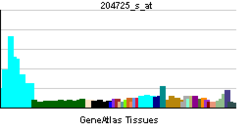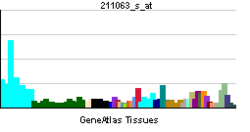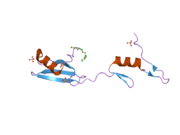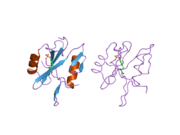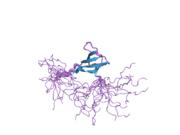- NCK1
-
Cytoplasmic protein NCK1 is a protein that in humans is encoded by the NCK1 gene.[1][2]
The Nck(non-catalytic region of tyrosine kinase adaptor protein 1)Protein belongs to the adaptor family of proteins.The nck gene was initially isolated from a human melanoma cDNA library using a monoclonal antibody produced against the human melanoma-associated antigen. The Nck family has two known members in human cells (Nck-1/Nckalpha and NcK2/NcKbeta), two in mouse cells (mNckalpha and mNckbeta/Grb4) and one in drosophila (Dock means dreadlocks-ortholog). The two murine gene products exhibit 68% aminoacid identity to one another,with most of the sequence variation being located to the linker regions between the SH3 and SH2 domains, and are 96% identical to their human counterparts. While human nck-1 gene has been localised to the 3q21 locus of chromosome 3, the nck-2 gene can be found on chromosome 2 at the 2q12 locus. The protein encoded by this gene is one of the signaling and transforming proteins containing Src homology 2 and 3 (SH2 and SH3) domains. It is located in the cytoplasm and is an adaptor protein involved in transducing signals from receptor tyrosine kinases to downstream signal recipients such as RAS.[3]
Contents
Interactions
NCK1 has been shown to interact with DNM1,[4] EIF2B2,[5] KHDRBS1,[6][7] Lymphocyte cytosolic protein 2,[8][9] EPH receptor B1,[10] SOCS7,[11] MINK1,[12] MAP4K1,[13][14][15] MAP4K4,[16] Abl gene,[17][18] WIPF1,[19] RRAS,[20] Wiskott-Aldrich syndrome protein,[21][22][23] Epidermal growth factor receptor,[6][24][25] PDGFRB,[24][25] PTK2,[26][27] NCKIPSD,[28] RICS,[29] Cbl gene,[17][30] TANK-binding kinase 1,[31] SOS1,[4][25][32][33] Dystroglycan,[34] PAK1,[25][35][36] PKN2,[25][37] NEDD9,[26] WASL[38] and RASA1.[39]
See also
References
- ^ Huebner K, Kastury K, Druck T, Salcini AE, Lanfrancone L, Pelicci G, Lowenstein E, Li W et al. (Jan 1995). "Chromosome locations of genes encoding human signal transduction adapter proteins, Nck (NCK), Shc (SHC1), and Grb2 (GRB2)". Genomics 22 (2): 281–7. doi:10.1006/geno.1994.1385. PMID 7806213.
- ^ Chen M, She H, Davis EM, Spicer CM, Kim L, Ren R, Le Beau MM, Li W (Oct 1998). "Identification of Nck family genes, chromosomal localization, expression, and signaling specificity". J Biol Chem 273 (39): 25171–8. doi:10.1074/jbc.273.39.25171. PMID 9737977.
- ^ "Entrez Gene: NCK1 NCK adaptor protein 1". http://www.ncbi.nlm.nih.gov/sites/entrez?Db=gene&Cmd=ShowDetailView&TermToSearch=4690.
- ^ a b Wunderlich, L; Faragó A, Buday L (Jan. 1999). "Characterization of interactions of Nck with Sos and dynamin". Cell. Signal. (ENGLAND) 11 (1): 25–9. doi:10.1016/S0898-6568(98)00027-8. ISSN 0898-6568. PMID 10206341.
- ^ Kebache, Sem; Zuo Dongmei, Chevet Eric, Larose Louise (Apr. 2002). "Modulation of protein translation by Nck-1". Proc. Natl. Acad. Sci. U.S.A. (United States) 99 (8): 5406–11. doi:10.1073/pnas.082483399. ISSN 0027-8424. PMC 122782. PMID 11959995. http://www.pubmedcentral.nih.gov/articlerender.fcgi?tool=pmcentrez&artid=122782.
- ^ a b Tang, J; Feng G S, Li W (Oct. 1997). "Induced direct binding of the adapter protein Nck to the GTPase-activating protein-associated protein p62 by epidermal growth factor". Oncogene (ENGLAND) 15 (15): 1823–32. doi:10.1038/sj.onc.1201351. ISSN 0950-9232. PMID 9362449.
- ^ Lawe, D C; Hahn C, Wong A J (Jan. 1997). "The Nck SH2/SH3 adaptor protein is present in the nucleus and associates with the nuclear protein SAM68". Oncogene (ENGLAND) 14 (2): 223–31. doi:10.1038/sj.onc.1200821. ISSN 0950-9232. PMID 9010224.
- ^ Shim, Eun Kyung; Moon Chang Suk, Lee Gi Yeon, Ha Yun Jung, Chae Suhn-Kee, Lee Jong Ran (Sep. 2004). "Association of the Src homology 2 domain-containing leukocyte phosphoprotein of 76 kD (SLP-76) with the p85 subunit of phosphoinositide 3-kinase". FEBS Lett. (Netherlands) 575 (1–3): 35–40. doi:10.1016/j.febslet.2004.07.090. ISSN 0014-5793. PMID 15388330.
- ^ Wunderlich, L; Faragó A, Downward J, Buday L (Apr. 1999). "Association of Nck with tyrosine-phosphorylated SLP-76 in activated T lymphocytes". Eur. J. Immunol. (GERMANY) 29 (4): 1068–75. doi:10.1002/(SICI)1521-4141(199904)29:04<1068::AID-IMMU1068>3.0.CO;2-P. ISSN 0014-2980. PMID 10229072.
- ^ Stein, E; Huynh-Do U, Lane A A, Cerretti D P, Daniel T O (Jan. 1998). "Nck recruitment to Eph receptor, EphB1/ELK, couples ligand activation to c-Jun kinase". J. Biol. Chem. (UNITED STATES) 273 (3): 1303–8. doi:10.1074/jbc.273.3.1303. ISSN 0021-9258. PMID 9430661.
- ^ Matuoka, K; Miki H, Takahashi K, Takenawa T (Oct. 1997). "A novel ligand for an SH3 domain of the adaptor protein Nck bears an SH2 domain and nuclear signaling motifs". Biochem. Biophys. Res. Commun. (UNITED STATES) 239 (2): 488–92. doi:10.1006/bbrc.1997.7492. ISSN 0006-291X. PMID 9344857.
- ^ Hu, Yuanming; Leo Cindy, Yu Simon, Huang Betty C B, Wang Hank, Shen Mary, Luo Ying, Daniel-Issakani Sarkiz, Payan Donald G, Xu Xiang (Dec. 2004). "Identification and functional characterization of a novel human misshapen/Nck interacting kinase-related kinase, hMINK beta". J. Biol. Chem. (United States) 279 (52): 54387–97. doi:10.1074/jbc.M404497200. ISSN 0021-9258. PMID 15469942.
- ^ Anafi, M; Kiefer F, Gish G D, Mbamalu G, Iscove N N, Pawson T (Oct. 1997). "SH2/SH3 adaptor proteins can link tyrosine kinases to a Ste20-related protein kinase, HPK1". J. Biol. Chem. (UNITED STATES) 272 (44): 27804–11. doi:10.1074/jbc.272.44.27804. ISSN 0021-9258. PMID 9346925.
- ^ Ling, P; Yao Z, Meyer C F, Wang X S, Oehrl W, Feller S M, Tan T H (Feb. 1999). "Interaction of hematopoietic progenitor kinase 1 with adapter proteins Crk and CrkL leads to synergistic activation of c-Jun N-terminal kinase". Mol. Cell. Biol. (UNITED STATES) 19 (2): 1359–68. ISSN 0270-7306. PMC 116064. PMID 9891069. http://www.pubmedcentral.nih.gov/articlerender.fcgi?tool=pmcentrez&artid=116064.
- ^ Ling, P; Meyer C F, Redmond L P, Shui J W, Davis B, Rich R R, Hu M C, Wange R L, Tan T H (Jun. 2001). "Involvement of hematopoietic progenitor kinase 1 in T cell receptor signaling". J. Biol. Chem. (United States) 276 (22): 18908–14. doi:10.1074/jbc.M101485200. ISSN 0021-9258. PMID 11279207.
- ^ Su, Y C; Han J, Xu S, Cobb M, Skolnik E Y (Mar. 1997). "NIK is a new Ste20-related kinase that binds NCK and MEKK1 and activates the SAPK/JNK cascade via a conserved regulatory domain". EMBO J. (ENGLAND) 16 (6): 1279–90. doi:10.1093/emboj/16.6.1279. ISSN 0261-4189. PMC 1169726. PMID 9135144. http://www.pubmedcentral.nih.gov/articlerender.fcgi?tool=pmcentrez&artid=1169726.
- ^ a b Miyoshi-Akiyama, T; Aleman L M, Smith J M, Adler C E, Mayer B J (Jul. 2001). "Regulation of Cbl phosphorylation by the Abl tyrosine kinase and the Nck SH2/SH3 adaptor". Oncogene (England) 20 (30): 4058–69. doi:10.1038/sj.onc.1204528. ISSN 0950-9232. PMID 11494134.
- ^ Ren, R; Ye Z S, Baltimore D (Apr. 1994). "Abl protein-tyrosine kinase selects the Crk adapter as a substrate using SH3-binding sites". Genes Dev. (UNITED STATES) 8 (7): 783–95. doi:10.1101/gad.8.7.783. ISSN 0890-9369. PMID 7926767.
- ^ Antón, I M; Lu W, Mayer B J, Ramesh N, Geha R S (Aug. 1998). "The Wiskott-Aldrich syndrome protein-interacting protein (WIP) binds to the adaptor protein Nck". J. Biol. Chem. (UNITED STATES) 273 (33): 20992–5. doi:10.1074/jbc.273.33.20992. ISSN 0021-9258. PMID 9694849.
- ^ Wang, B; Zou J X, Ek-Rylander B, Ruoslahti E (Feb. 2000). "R-Ras contains a proline-rich site that binds to SH3 domains and is required for integrin activation by R-Ras". J. Biol. Chem. (UNITED STATES) 275 (7): 5222–7. doi:10.1074/jbc.275.7.5222. ISSN 0021-9258. PMID 10671570.
- ^ Krause, M; Sechi A S, Konradt M, Monner D, Gertler F B, Wehland J (Apr. 2000). "Fyn-binding protein (Fyb)/SLP-76-associated protein (SLAP), Ena/vasodilator-stimulated phosphoprotein (VASP) proteins and the Arp2/3 complex link T cell receptor (TCR) signaling to the actin cytoskeleton". J. Cell Biol. (UNITED STATES) 149 (1): 181–94. doi:10.1083/jcb.149.1.181. ISSN 0021-9525. PMC 2175102. PMID 10747096. http://www.pubmedcentral.nih.gov/articlerender.fcgi?tool=pmcentrez&artid=2175102.
- ^ Okabe, Seiichi; Fukuda Seiji, Broxmeyer Hal E (Jul. 2002). "Activation of Wiskott-Aldrich syndrome protein and its association with other proteins by stromal cell-derived factor-1alpha is associated with cell migration in a T-lymphocyte line". Exp. Hematol. (Netherlands) 30 (7): 761–6. doi:10.1016/S0301-472X(02)00823-8. ISSN 0301-472X. PMID 12135674.
- ^ Rivero-Lezcano, O M; Marcilla A, Sameshima J H, Robbins K C (Oct. 1995). "Wiskott-Aldrich syndrome protein physically associates with Nck through Src homology 3 domains". Mol. Cell. Biol. (UNITED STATES) 15 (10): 5725–31. ISSN 0270-7306. PMC 230823. PMID 7565724. http://www.pubmedcentral.nih.gov/articlerender.fcgi?tool=pmcentrez&artid=230823.
- ^ a b Li, W; Hu P, Skolnik E Y, Ullrich A, Schlessinger J (Dec. 1992). "The SH2 and SH3 domain-containing Nck protein is oncogenic and a common target for phosphorylation by different surface receptors". Mol. Cell. Biol. (UNITED STATES) 12 (12): 5824–33. ISSN 0270-7306. PMC 360522. PMID 1333047. http://www.pubmedcentral.nih.gov/articlerender.fcgi?tool=pmcentrez&artid=360522.
- ^ a b c d e Braverman, L E; Quilliam L A (Feb. 1999). "Identification of Grb4/Nckbeta, a src homology 2 and 3 domain-containing adapter protein having similar binding and biological properties to Nck". J. Biol. Chem. (UNITED STATES) 274 (9): 5542–9. doi:10.1074/jbc.274.9.5542. ISSN 0021-9258. PMID 10026169.
- ^ a b Minegishi, M; Tachibana K, Sato T, Iwata S, Nojima Y, Morimoto C (Oct. 1996). "Structure and function of Cas-L, a 105-kD Crk-associated substrate-related protein that is involved in beta 1 integrin-mediated signaling in lymphocytes". J. Exp. Med. (UNITED STATES) 184 (4): 1365–75. doi:10.1084/jem.184.4.1365. ISSN 0022-1007. PMC 2192828. PMID 8879209. http://www.pubmedcentral.nih.gov/articlerender.fcgi?tool=pmcentrez&artid=2192828.
- ^ Goicoechea, Silvia M; Tu Yizeng, Hua Yun, Chen Ka, Shen Tang-Long, Guan Jun-Lin, Wu Chuanyue (Jul. 2002). "Nck-2 interacts with focal adhesion kinase and modulates cell motility". Int. J. Biochem. Cell Biol. (England) 34 (7): 791–805. doi:10.1016/S1357-2725(02)00002-X. ISSN 1357-2725. PMID 11950595.
- ^ Lim, C S; Park E S, Kim D J, Song Y H, Eom S H, Chun J S, Kim J H, Kim J K, Park D, Song W K (Apr. 2001). "SPIN90 (SH3 protein interacting with Nck, 90 kDa), an adaptor protein that is developmentally regulated during cardiac myocyte differentiation". J. Biol. Chem. (United States) 276 (16): 12871–8. doi:10.1074/jbc.M009411200. ISSN 0021-9258. PMID 11278500.
- ^ Zhao, Chunmei; Ma Hong, Bossy-Wetzel Ella, Lipton Stuart A, Zhang Zhuohua, Feng Gen-Sheng (Sep. 2003). "GC-GAP, a Rho family GTPase-activating protein that interacts with signaling adapters Gab1 and Gab2". J. Biol. Chem. (United States) 278 (36): 34641–53. doi:10.1074/jbc.M304594200. ISSN 0021-9258. PMID 12819203.
- ^ Erdreich-Epstein, A; Liu M, Kant A M, Izadi K D, Nolta J A, Durden D L (Apr. 1999). "Cbl functions downstream of Src kinases in Fc gamma RI signaling in primary human macrophages". J. Leukoc. Biol. (UNITED STATES) 65 (4): 523–34. ISSN 0741-5400. PMID 10204582.
- ^ Chou, M M; Hanafusa H (Mar. 1995). "A novel ligand for SH3 domains. The Nck adaptor protein binds to a serine/threonine kinase via an SH3 domain". J. Biol. Chem. (UNITED STATES) 270 (13): 7359–64. doi:10.1074/jbc.270.13.7359. ISSN 0021-9258. PMID 7706279.
- ^ Hu, Q; Milfay D, Williams L T (Mar. 1995). "Binding of NCK to SOS and activation of ras-dependent gene expression". Mol. Cell. Biol. (UNITED STATES) 15 (3): 1169–74. ISSN 0270-7306. PMC 230339. PMID 7862111. http://www.pubmedcentral.nih.gov/articlerender.fcgi?tool=pmcentrez&artid=230339.
- ^ Okada, S; Pessin J E (Oct. 1996). "Interactions between Src homology (SH) 2/SH3 adapter proteins and the guanylnucleotide exchange factor SOS are differentially regulated by insulin and epidermal growth factor". J. Biol. Chem. (UNITED STATES) 271 (41): 25533–8. doi:10.1074/jbc.271.41.25533. ISSN 0021-9258. PMID 8810325.
- ^ Sotgia, F; Lee H, Bedford M T, Petrucci T, Sudol M, Lisanti M P (Dec. 2001). "Tyrosine phosphorylation of beta-dystroglycan at its WW domain binding motif, PPxY, recruits SH2 domain containing proteins". Biochemistry (United States) 40 (48): 14585–92. doi:10.1021/bi011247r. ISSN 0006-2960. PMID 11724572.
- ^ Ku, G M; Yablonski D, Manser E, Lim L, Weiss A (Feb. 2001). "A PAK1-PIX-PKL complex is activated by the T-cell receptor independent of Nck, Slp-76 and LAT". EMBO J. (England) 20 (3): 457–65. doi:10.1093/emboj/20.3.457. ISSN 0261-4189. PMC 133476. PMID 11157752. http://www.pubmedcentral.nih.gov/articlerender.fcgi?tool=pmcentrez&artid=133476.
- ^ Bokoch, G M; Wang Y, Bohl B P, Sells M A, Quilliam L A, Knaus U G (Oct. 1996). "Interaction of the Nck adapter protein with p21-activated kinase (PAK1)". J. Biol. Chem. (UNITED STATES) 271 (42): 25746–9. doi:10.1074/jbc.271.42.25746. ISSN 0021-9258. PMID 8824201.
- ^ Quilliam, L A; Lambert Q T, Mickelson-Young L A, Westwick J K, Sparks A B, Kay B K, Jenkins N A, Gilbert D J, Copeland N G, Der C J (Nov. 1996). "Isolation of a NCK-associated kinase, PRK2, an SH3-binding protein and potential effector of Rho protein signaling". J. Biol. Chem. (UNITED STATES) 271 (46): 28772–6. doi:10.1074/jbc.271.46.28772. ISSN 0021-9258. PMID 8910519.
- ^ Rohatgi, R; Nollau P, Ho H Y, Kirschner M W, Mayer B J (Jul. 2001). "Nck and phosphatidylinositol 4,5-bisphosphate synergistically activate actin polymerization through the N-WASP-Arp2/3 pathway". J. Biol. Chem. (United States) 276 (28): 26448–52. doi:10.1074/jbc.M103856200. ISSN 0021-9258. PMID 11340081.
- ^ Ger, M; Zitkus Z, Valius M (Oct. 2011). "Adaptor protein Nck1 interacts with p120 Ras GTPase-activating protein and regulates its activity". Cell. Signal. (ENGLAND) 23 (10): 1651–8. doi:10.1016/j.cellsig.2011.05.019. ISSN 0898-6568. PMID 21664272.
Further reading
- Iwata S, Ohashi Y, Kamiguchi K, Morimoto C (2000). "Beta 1-integrin-mediated cell signaling in T lymphocytes". J. Dermatol. Sci. 23 (2): 75–86. doi:10.1016/S0923-1811(99)00096-1. PMID 10808124.
- Park D, Rhee SG (1992). "Phosphorylation of Nck in response to a variety of receptors, phorbol myristate acetate, and cyclic AMP". Mol. Cell. Biol. 12 (12): 5816–23. PMC 360521. PMID 1333046. http://www.pubmedcentral.nih.gov/articlerender.fcgi?tool=pmcentrez&artid=360521.
- Meisenhelder J, Hunter T (1992). "The SH2/SH3 domain-containing protein Nck is recognized by certain anti-phospholipase C-gamma 1 monoclonal antibodies, and its phosphorylation on tyrosine is stimulated by platelet-derived growth factor and epidermal growth factor treatment". Mol. Cell. Biol. 12 (12): 5843–56. PMC 360524. PMID 1448108. http://www.pubmedcentral.nih.gov/articlerender.fcgi?tool=pmcentrez&artid=360524.
- Lehmann JM, Riethmüller G, Johnson JP (1990). "Nck, a melanoma cDNA encoding a cytoplasmic protein consisting of the src homology units SH2 and SH3". Nucleic Acids Res. 18 (4): 1048. doi:10.1093/nar/18.4.1048. PMC 330365. PMID 2107526. http://www.pubmedcentral.nih.gov/articlerender.fcgi?tool=pmcentrez&artid=330365.
- Rivero-Lezcano OM, Sameshima JH, Marcilla A, Robbins KC (1994). "Physical association between Src homology 3 elements and the protein product of the c-cbl proto-oncogene". J. Biol. Chem. 269 (26): 17363–6. PMID 7517397.
- Rivero-Lezcano OM, Marcilla A, Sameshima JH, Robbins KC (1995). "Wiskott-Aldrich syndrome protein physically associates with Nck through Src homology 3 domains". Mol. Cell. Biol. 15 (10): 5725–31. PMC 230823. PMID 7565724. http://www.pubmedcentral.nih.gov/articlerender.fcgi?tool=pmcentrez&artid=230823.
- Chou MM, Hanafusa H (1995). "A novel ligand for SH3 domains. The Nck adaptor protein binds to a serine/threonine kinase via an SH3 domain". J. Biol. Chem. 270 (13): 7359–64. doi:10.1074/jbc.270.13.7359. PMID 7706279.
- Hu Q, Milfay D, Williams LT (1995). "Binding of NCK to SOS and activation of ras-dependent gene expression". Mol. Cell. Biol. 15 (3): 1169–74. PMC 230339. PMID 7862111. http://www.pubmedcentral.nih.gov/articlerender.fcgi?tool=pmcentrez&artid=230339.
- Vorobieva N, Protopopov A, Protopopova M et al. (1994). "Localization of human ARF2 and NCK genes and 13 other NotI-linking clones to chromosome 3 by fluorescence in situ hybridization". Cytogenet. Cell Genet. 68 (1–2): 91–4. doi:10.1159/000133898. PMID 7956370.
- Kitamura T, Kitamura Y, Yonezawa K et al. (1996). "Molecular cloning of p125Nap1, a protein that associates with an SH3 domain of Nck". Biochem. Biophys. Res. Commun. 219 (2): 509–14. doi:10.1006/bbrc.1996.0264. PMID 8605018.
- Okada S, Pessin JE (1996). "Interactions between Src homology (SH) 2/SH3 adapter proteins and the guanylnucleotide exchange factor SOS are differentially regulated by insulin and epidermal growth factor". J. Biol. Chem. 271 (41): 25533–8. doi:10.1074/jbc.271.41.25533. PMID 8810325.
- Bokoch GM, Wang Y, Bohl BP et al. (1996). "Interaction of the Nck adapter protein with p21-activated kinase (PAK1)". J. Biol. Chem. 271 (42): 25746–9. doi:10.1074/jbc.271.42.25746. PMID 8824201.
- Minegishi M, Tachibana K, Sato T et al. (1996). "Structure and function of Cas-L, a 105-kD Crk-associated substrate-related protein that is involved in beta 1 integrin-mediated signaling in lymphocytes". J. Exp. Med. 184 (4): 1365–75. doi:10.1084/jem.184.4.1365. PMC 2192828. PMID 8879209. http://www.pubmedcentral.nih.gov/articlerender.fcgi?tool=pmcentrez&artid=2192828.
- Roche S, McGlade J, Jones M et al. (1996). "Requirement of phospholipase C gamma, the tyrosine phosphatase Syp and the adaptor proteins Shc and Nck for PDGF-induced DNA synthesis: evidence for the existence of Ras-dependent and Ras-independent pathways". EMBO J. 15 (18): 4940–8. PMC 452231. PMID 8890167. http://www.pubmedcentral.nih.gov/articlerender.fcgi?tool=pmcentrez&artid=452231.
- Quilliam LA, Lambert QT, Mickelson-Young LA et al. (1997). "Isolation of a NCK-associated kinase, PRK2, an SH3-binding protein and potential effector of Rho protein signaling". J. Biol. Chem. 271 (46): 28772–6. doi:10.1074/jbc.271.46.28772. PMID 8910519.
- Lussier G, Larose L (1997). "A casein kinase I activity is constitutively associated with Nck". J. Biol. Chem. 272 (5): 2688–94. doi:10.1074/jbc.272.5.2688. PMID 9006905.
- Lawe DC, Hahn C, Wong AJ (1997). "The Nck SH2/SH3 adaptor protein is present in the nucleus and associates with the nuclear protein SAM68". Oncogene 14 (2): 223–31. doi:10.1038/sj.onc.1200821. PMID 9010224.
- Lu W, Katz S, Gupta R, Mayer BJ (1997). "Activation of Pak by membrane localization mediated by an SH3 domain from the adaptor protein Nck". Curr. Biol. 7 (2): 85–94. doi:10.1016/S0960-9822(06)00052-2. PMID 9024622.
- Su YC, Han J, Xu S et al. (1997). "NIK is a new Ste20-related kinase that binds NCK and MEKK1 and activates the SAPK/JNK cascade via a conserved regulatory domain". EMBO J. 16 (6): 1279–90. doi:10.1093/emboj/16.6.1279. PMC 1169726. PMID 9135144. http://www.pubmedcentral.nih.gov/articlerender.fcgi?tool=pmcentrez&artid=1169726.
External links
- Nck1 Info with links in the Cell Migration Gateway
PDB gallery Categories:- Human proteins
Wikimedia Foundation. 2010.


